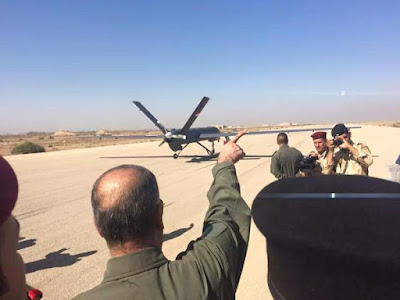By @green_lemonnn
5- Yassir drone used by Harkat Al Nujaba
http://www.uskowioniran.com/2014/12/yasir-uav-in-use-with-harakat-hizballah.html
6- https://www.youtube.com/watch?v=ZKioGk3bSqw
7 - https://youtu.be/I1ee6PLfFzU?t=2m7s
8- Note that an Ababil 3 with Iraqi markings was downed in the same province and made it to an "Islamic state" propaganda video https://archive.org/details/aali2006aa_yahoo_20150214#
If Iranian drones in Iraq are new to you, please make you sure have read Adam Rawnsley articles on this subject (1).
Since the Fall of Mosul one year ago, Iran is fully committed to the Iraqi government in his anti-"Islamic State" organization fight. On the ground, the army of the Guardians of the Islamic Revolution (IRGC) advisors were dispatched on various fronts to support Iraqi security forces. On the air, Iranian air force occasionally bombed Islamic State positions in Diyala & Salahuddin provinces (2). Iranian drones also joined the battle in the early July 2014 (3). While it's still unclear if the drones are operated by Iranian operators, it's now well known that Iranian made drones are used under Iraqi flag (4) or directly by Popular Mobilisation units (5).
On the 13th June 2015, Al Etejah TV, a pro-Iranian Iraqi TV channel, aired a video of Kataib Hezbollah's "Basir 1" drone flying near the city of Baiji in Salahuddin province (6). The video shows a reconnaissance drone monitoring what looks like 2 "Islamic State" Suicide VBIEDs. The interesting part of the video is actually the data surrounding it. A closer look reveals the similarity between the drone formatting metadata in Al Etejah video and a video of Iran most advanced drone, Shahed 129, aired by Iranian Channel 2 during the 9th Great Prophet wargame (February 2015) (7) . That said, the drone seen in video isn't a Shahed 129 but an Ababil 3 (8). You can clearly see the Ababil 3 lading gear at 1:30. This suggests Ababil-3 & Shahed 129 use a similar video processing software despite having a different sensor.
Special thanks to Adam Rawnsley (@arawnsley) and Arnaud Delalande (@Arn_Del)
Sources
1- Adam Rawnsley articles :
2- Babak Taghavee interview with The aviation
3- Picture posted on 4th July 2014 by Islamic State social media shows a Mohajer 4 drone lost west of Samara.
5- Yassir drone used by Harkat Al Nujaba
http://www.uskowioniran.com/2014/12/yasir-uav-in-use-with-harakat-hizballah.html
6- https://www.youtube.com/watch?v=ZKioGk3bSqw
7 - https://youtu.be/I1ee6PLfFzU?t=2m7s
8- Note that an Ababil 3 with Iraqi markings was downed in the same province and made it to an "Islamic state" propaganda video https://archive.org/details/aali2006aa_yahoo_20150214#






















































































